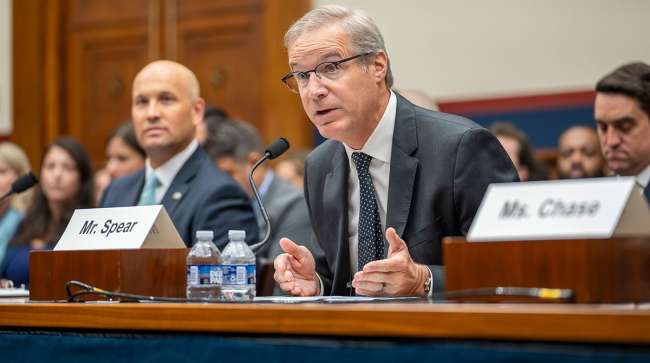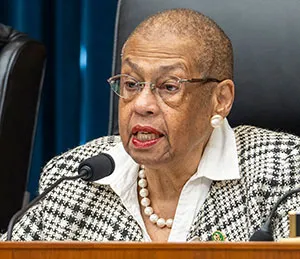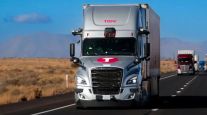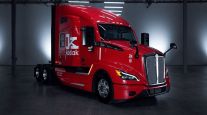Senior Reporter
ATA Leader Chris Spear Presses Congress for AV Framework

[Stay on top of transportation news: Get TTNews in your inbox.]
WASHINGTON — Automated vehicles would gain greater adoption with a nationwide policy framework, Chris Spear, president of American Trucking Associations, told members of Congress on Sept. 13.
Addressing the U.S. House panel on highways and transit operations, Spear touted the technology’s potential benefits linked to safety, the workforce and the freight supply chain.
“What’s needed first is a national framework that encourages development, testing and deployment of technology, in direct support of interstate commerce,” the ATA leader told House lawmakers, cautioning that a landscape of state-centric rules governing the technology will eventually lead to regulatory challenges.
“Federal guidance should treat commercial and passenger vehicles equally and require automated vehicles to achieve an acceptable level of safety and performance rather than requiring the use of specific technologies,” Spear continued. “The ATA and its members commit to working with this subcommittee to help shape this framework, blending technological value with operational realities that reduce highway injuries and fatalities.”
The ongoing modernization of commercial trucks also will serve as a tool for recruiting and retaining individuals interested in joining firms industrywide. Said Spear: “We believe it is vital to attracting the next generation of talent into the profession.”
Responding to several Democrats’ concerns related to the freight workforce, Spear affirmed autonomous trucking technologies would not lead to disruptions. ATA recently determined the trucking workforce is short about 78,000 drivers. As Spear put it, “Displacement is not a concern. We see zero evidence of that. Other than baseless rhetoric and emotion, we’re not seeing any evidence of that. And the reason is that we have a shortage of talent. It’s a growing shortage of talent. As long as that exists, innovation has a place to thrive in terms of supplementing our industry’s ability to meet economic demand.”

Farrah
ATA is among myriad stakeholders calling on members of Congress to facilitate AVs’ mainstream adoption in the marketplace. At the hearing, Jeff Farrah, executive director of the Autonomous Vehicle Industry Association, touched on the potential improvements associated with incorporating the technology in the commercial transportation arena. “The further deployment and integration of autonomous trucks into America’s logistics network will help optimize the transportation of freight nationwide, bringing goods directly to consumers faster and helping to ease the ongoing supply chain crisis,” Farrah argued. “At present, the United States is not hauling all the freight it could, and this is holding back our farmers, ranchers and manufacturers. This gap is due to a variety of factors, including a truck driver shortage that the American Trucking Associations estimates to be nearly 78,000 truck drivers. This number is set to double by 2031. Autonomous trucking offers a means to address supply chain inefficiencies by filling workforce gaps, enhancing fleet flexibility and reducing travel times.”
Congressional legislation specific to autonomous vehicles introduced this year has yet to reach the president’s desk for enactment. Rep. Rick Crawford (R-Ark.), the subcommittee’s chairman, pointed to AVs’ focus on safety. Noting the National Highway Traffic Safety Administration estimated that nearly 43,000 individuals died in motor vehicle accidents in 2022, Crawford said, “Autonomous trucks can increase safety on our nation’s roadways and save lives.”
“The good news,” the chairman added, “is that we know the major source of these crashes — a whopping 94% of serious crashes — are due to driver factors, such as speeding or driving while fatigued, impaired or distracted.”
“Autonomous vehicle trucks, like AV cars, help us with anticipating road dangers and mitigating or removing human error from the chain of events that lead to a crash, thereby reducing the number of accidents caused by human error. In addition, autonomous trucks can strengthen our supply chain,” Crawford went on.

Del. Eleanor Holmes Norton pointed to safety as the central issue regarding the technology. (SunJae Smith/American Trucking Associations)
Del. Eleanor Holmes Norton (D-D.C.) also pointed to safety as being the central issue regarding the technology. “We are experiencing a startling rise in roadway fatalities,” she noted. “Autonomous vehicles have the potential to save lives by reducing traffic crashes caused by human behavior, but that potential is not a guarantee. Potential safety benefits must be carefully weighed against risks, especially when public roads are being used as testing grounds for new technologies.”
“While the status quo on highway fatalities is unacceptable, AVs must be held to the highest safety standards as they are developed and deployed. We can’t substitute one inadequate system for another,” observed Rep. Rick Larsen (D-Wash.), the committee’s ranking member.
Want more news? Listen to today's daily briefing below or go here for more info:




